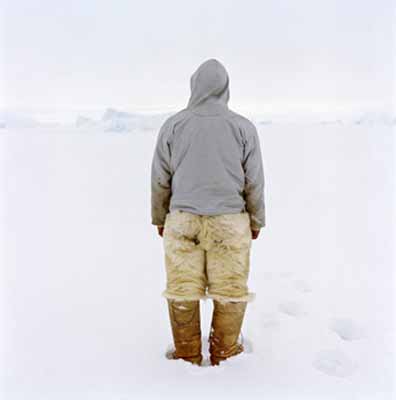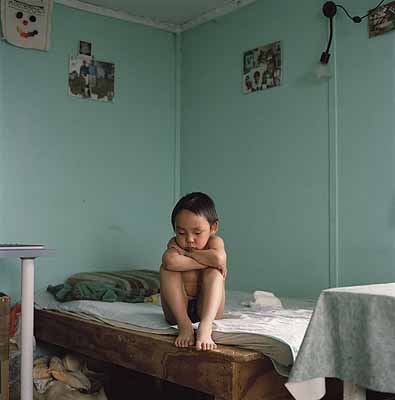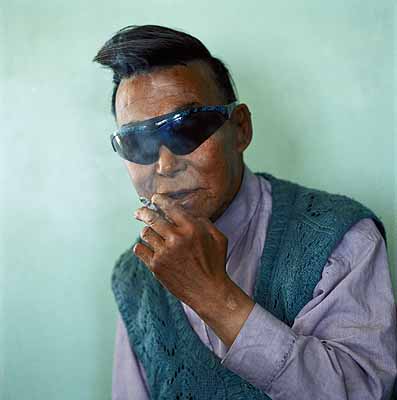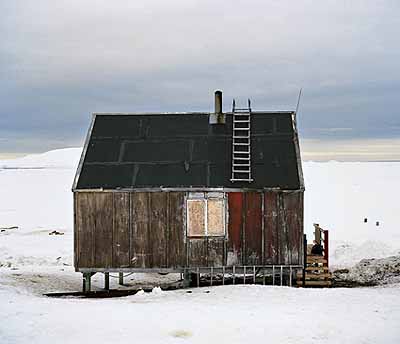
Tiina Itkonen »
Inughuit
Exhibition: 28 Jan – 19 Mar 2005
"The Arctic has fascinated explorers, adventurers, traders and whalers ever since ancient times. And since the beginning of the 1990s, I have been searching for my own Ultima Thule, my place in the Far North. I was enchanted by the story of the Mother of the Sea and, in 1995, it inspired me to set off for the place where the story originated in Greenland. My search for the Mother of the Sea took me to the Polar Eskimos of the northernmost part of Greenland. The lack of haste, the friendliness of the people, the silence of the glaciers and the peace of the landscape compelled me to return to Northwest Greenland in 1998 and 2002. These memories take me back to Thule, to Northwest Greenland. When I close my eyes I am in Thule, and the silence is perfect. Blueish light dances across the snow; the icebergs glow turquoise. The silence is broken by a loud crack. An iceberg splits, creating new, smaller icebergs. In an instant, the light transforms the landscape from beautifully mellow to frighteningly sombre. In Thule there are no roads that I could take to get away. I follow my own paths. In Thule there are no trees: I can see the horizon far off in all directions. I am incapable of judging distances. I am not used to seeing this far. Here everything happens immaqa agaqu – maybe tomorrow. And again the next day, they say immaqa agaqu. Polar Eskimos live according to the weather and the seasons. If the weather permits, the men set out to hunt, while their families may travel to a neighbouring village to visit relatives – even in the middle of the night. Nobody is in any hurry anywhere. There is as much time to do things as they require. There is also time for other people. They visit each other, play cards, mend hunting gear, sew fur clothes, do beadwork, play the organ or just are. And nor is there any need to talk; you can simply be quiet. During the four-month ‘day’, there is really no need to sleep, since you get a lot of sleep during the four-month ‘night’. On my first trip, it was hard to get to know people, because I did not speak the Polar Eskimo language. I learned some simple phrases about the weather from an English-Greenlandic dictionary. I could say sila nuanneq – beautiful weather – or issippoq – it is cold. My Greenlandic vocabulary expanded rapidly when I lived with people. On my second and third trips, I was able to talk about subjects other than the weather. The polar-bear scalp I was given by Taateraaq takes my thoughts to Savissivik. Hunting trips with a dogsled, spending the night in a tent on the edge of a glacier, catching little auks with a net on the slopes of a mountain, walks on the ice in the morning sun, taking part in a dogsled race, football matches in soft snow, a skiing competition without ski poles – all unforgettable experiences. Now and then, I hear news from Thule. Juulut rings from Qaanaaq and tells me when the first snow is falling and whether you can drive a dogsled across the ice. I also get to hear when Aqatannguaq from the neighbouring village has a birthday or when Taateraaq, the oldest person in Savissivik, has come on a visit to Qaanaaq. E-mail messages from the villages tell me that life goes on as before. On my first trip to Greenland, I was told I would definitely be coming back. According to a Greenlandic tale, a human being can turn into a qivigtoq, run around the fells, live there, and finally die there. My desire to return to Greenland goes beyond reason. On my third trip there I tried to shake off this ‘madness’ and leave it wandering in the northern landscapes, like a qivigtoq. I did not succeed". Tiina Itkonen Finnish contemporary photographer Tiina Itkonen (b.1968) studied photography at the school of Art Communication in Turku and at the university of Art and Design Helsinki. She has been exhibiting in Finland and abroad since 1996. Her works are in the following collections: Moderna Museet in Stockholm, Helsinki City Art Museum, The finnish Museum of Photography and the finnish State Art Collection. Tiina Itkonen was”Finnish Young Photographer of the Year 2003” and the Fotofinlandia finalist in 1996 and 2004. She has spent four months living with Polar Eskimos in Northern Greenland during 1995, 1998 and 2002, on two of these occasions with Eva Jansson. Editions Tiina Itkonen, Inughuit ISBN 952-91-6967-1 Exhibitions: Tiina Itkonen "Inughuit" also at: Michael Hoppen Contemporary GB-London Feb 4 - Mar 24 Preview Feb 3 Synart Art Gallery D-Frankfurt Mar 2 - Apr 9 Vernissage Mar 2, 6.30 p.m ______________________________ " L’Arctique fascine explorateurs, aventuriers, marchands et pêcheurs de baleines depuis des temps ancestraux. Depuis le début des années 90, je me suis mise en quête de mon propre Ultima Thule, mon endroit à moi dans le Grand Nord. La légende de la Mère de l’Océan me captivait et, en 1995, j’ai eu envie de partir à la recherche du lieu où l’histoire vit le jour, au Groenland. Ma quête de la Mère de l’Océan me mena aux Esquimaux Polaires qui vivent à l’extrême nord du Groenland. Le calme, la gentillesse de ce peuple, le silence des glaciers et la paix émanant du paysage me poussèrent à y revenir en 1998 et en 2002. Ces souvenirs me ramènent à Thule, au nord-ouest du Groenland. Quand je ferme les yeux, je suis à Thule, et le silence est parfait. Une lumière bleue danse sur la neige ; les icebergs émettent une douce lueur turquoise. Un craquement bruyant brise le silence. Un iceberg se fend et crée de nouveaux petits icebergs. En un instant, sous la lumière changeante, la douce beauté du paysage fait place à une obscurité effrayante. A Thule, il n’y a pas de chemin par lequel je puisse m’échapper. Je suis mes propres sentiers. A Thule, il n’y a pas d’arbres : je vois l’horizon à perte de vue dans toutes les directions. Je suis incapable d’évaluer les distances. Je ne suis pas habituée à voir aussi loin. Ni je suis habituée à cette conception du temps où tout arrive immaqa agaqu - demain peut-être. Et le jour suivant aussi, ils disent immaqa agu. Les Esquimaux Polaires vivent au rythme du temps et des saisons. Si le temps le permet, les hommes partent à la chasse, pendant que leur famille se rend au village voisin pour rendre visite à des proches – même au milieu de la nuit. Personne ne se presse nulle part. On prend autant de temps qu’il le faut pour faire les choses. On prend aussi le temps pour les autres. Ils se rendent visite les uns les autres, jouent aux cartes, réparent le matériel de chasse, cousent quelques vêtements, travaillent les perles, jouent de l’orgue ou sont, et c’est tout. Nul besoin de parler non plus ; on peut tout simplement rester silencieux. Pendant cette " journée de quatre mois ", on n’a vraiment aucun besoin de dormir, puisqu’on a dormi tout son soûl pendant la " nuit de quatre mois ". Lors de mon premier voyage, il m’était difficile de faire connaissance, parce que je ne parlais pas la langue esquimaude. J’ai appris quelques expressions simples à propos du temps dans un dictionnaire anglais-groenlandais. Je savais dire sila nuanneq – beau temps - ou issippoq – il fait froid. Mon vocabulaire groenlandais s’est rapidement enrichi quand j’ai vécu avec la population. Lors de mes second et troisième voyages, j’étais capable de parler d’autre chose que du temps. Le scalp d’ours polaire que Taateraaq m’a donné ramène mes pensées à Savissivik. Expéditions de chasse avec un traîneau tiré par des chiens, nuit passée sous la tente au pied d’un glacier, petits pingouins attrapés au filet sur les pentes d’une montagne, marches sur la neige dans le soleil matinal, course de traîneaux de chiens à laquelle je participai, matchs de foot dans la neige molle, compétition de ski sans bâtons – toutes des expériences inoubliables. Parfois, j’ai des nouvelles de Thule. Juulut m’appelle de Qaanaaq et me dit quand la première neige tombe et si on peut conduire un traîneau de chiens sur la glace. Il m’arrive aussi d’apprendre quand Aqatannguaq, du village voisin, fête son anniversaire ou quand Taateraaq, la personne la plus âgée de Savissivik, a rendu visite à Qaanaaq. Des emails provenant des villages m’apprennent que la vie continue de suivre son cours. Lors de mon premier voyage au Groenland, on m’a dit qu’il était évident que je reviendrais. D’après un conte groenlandais un être humain peut se transformer en qivigtoq, courir en rond sur la lande, vivre là, et y mourir. Mon désir de retourner au Groenland dépasse la raison. Lors de mon troisième voyage là-bas j’ai tenté de me débarrasser de cette " folie " et de la laisser errer dans les paysages nordiques, comme un qivigtoq. Je n’y suis pas arrivée ". Tiina Itkonen Eléments biographiques La photographe finlandaise Tiina Itkonen (née en 1968) a étudié la photographie à l’école de Communication Artistique de Turku et à l’université d’Art et de Design d’Helsinki. Elle expose en Finlande et à l’étranger depuis 1996. Ses oeuvres se trouvent dans les collections suivantes : le Moderna Museet de Stockholm, le City Art Museum d’Helsinki, le Musée finlandais de la Photographie et la State Art Collection finlandaise. Tiina Itkonen reçut le prix du " Meilleur Jeune Photographe finlandais de l’année" en 2003 et fut finaliste au Fotofinlandia en 1996 et 2004. Elle a passé quatre mois avec les Esquimaux Polaires au nord du Groenland en 1995, 1998, et 2002, deux fois en compagnie de Eva Jansson. Editions Tiina Itkonen, Inughuit ISBN 952-91-6967-1 Exhibitions: Tiina Itkonen "Inughuit" Michael Hoppen Contemporary GB-London Feb 4 - Mar 24 Preview Feb 3 Synart Art Gallery D-Frankfurt Mar 2 - Apr 9 Vernissage Mar 2, 6.30 p.m


